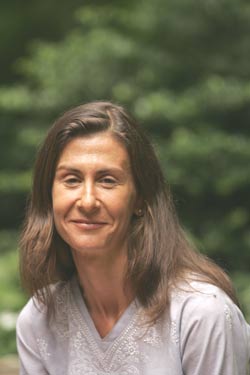
Photo by Bruce Gilbert
If Arancha Garcia del Soto, Ph.D., had her way, she would still be in Sri Lanka. That’s where she was a year ago—studying how psychosocial services are being implemented across the country.
In the midst of her travels, violence stemming from a 25-year-old civil war flared anew, forcing Sri Lankans from their homes and Garcia del Soto back to New York.
“I keep in touch with friends and colleagues there often, and hope to someday return,” she said. “It’s very interesting research.”
An expert on the effects of ethnopolitical violence on survivors, Garcia del Soto is the Helen Hamlyn Senior Fellow at Fordham’s International Institute for Humanitarian Affairs (IIHA). Over the years, she has collaborated with local and international organizations on building programs for survivors in the Balkans, West Africa, Latin America and Iraq, as well as Sri Lanka.
Her latest project focuses on the healing value of symbolic reparations—gestures such as erecting monuments or renaming streets to honor the survivors and victims of violence. Such reparations can take a variety of artistic forms, including music or graffiti. They aid the healing process for victims’ families by helping them remember loved ones.
Garcia del Soto realized the importance of symbolic reparations in 2004 while conducting research on educational and economic reparations in Peru. She began speaking to survivors about why such expressions appealed to them.
“I had tons of material, and put it together for a presentation just for fun because blending art with social sciences—in the eyes of the some people—is not considered very serious,” she said. “It all started like a beautiful game.”
Garcia del Soto held her first presentation at a one-week festival attended by university students, professors and professionals in Colombia—a country plagued by violence, insurgent and counter-insurgency groups and corruption.
“It was wonderful,” she said. “One of our main concerns was not only to provide the support of the expat—the foreigner working in a country other than his or her own—but to emphasize how important it is to do work with local professionals.
“They are the ones living and working in places, while our role is more external. So if we think in terms of promoting changes that are sustainable, it’s only through the local people—not only survivors but also professionals—that this can happen. That is really key in humanitarian aid work.”
Since them, Garcia del Soto has given presentations at Fordham and universities in Mexico and Spain on symbolic reparations and their healing powers.
“I love the project because it brings together my work with survivors of violence with the artistic works of everyday people and famous artists, she said.
For a scholar who is comfortable operating in global conflict zones, Garcia del Soto constantly shifts the spotlight away from herself and onto her colleagues and the institute they support.
“That is what this is about; the center and the work that we do here,” she said.
IIHA was established in 2001 to forge partnerships with relief organizations, publish books, create training programs and host symposia relating to humanitarian affairs. It also offers an academic home for the study of international health, human rights and other humanitarian issues, especially those that occur during conflicts.
The IIHA has published eight books and several articles, among other publications. IIHA staffers have been involved in research projects and humanitarian efforts in Nicaragua, Colombia, Peru, South Africa and Sri Lanka.
Three times a year, the institute runs a month-long program in International Diploma in Humanitarian Assistance (IDHA) for humanitarian workers, which boasts nearly 1,100 graduates.
“Our main goal is to teach,” Garcia del Soto said. “We support students, undergraduate or graduate, in their research and more applied international work, and provide linkages with universities that have groups doing emergency or development work. Our goal is to soon offer a master’s program in humanitarian affairs.”
Interest among Fordham collegians in humanitarian affairs is growing by leaps and bounds, she added.
“We get more and more requests from students to participate in our classes,” she said. “Humanitarian work as a profession is very young, but it is one that allows for the blending of different disciplines: law, social work, psychology and Latin American studies. [The increased interest] has to do, in part, with the fact that there is more exposure to international issues these days thanks to cable television and the Internet. I could dare to say there is more of a consciousness.
“Many people say humanitarian aid work combines a profession and a vocation,” Garcia del Soto said. “Part of our role is to shape the good doers and to align what we do along professional guidelines. We use books and materials, but we also use a lot of photos, videos and theatre. It is very much connected to different expressions of what’s going on at the local level of the countries in which we work.”

